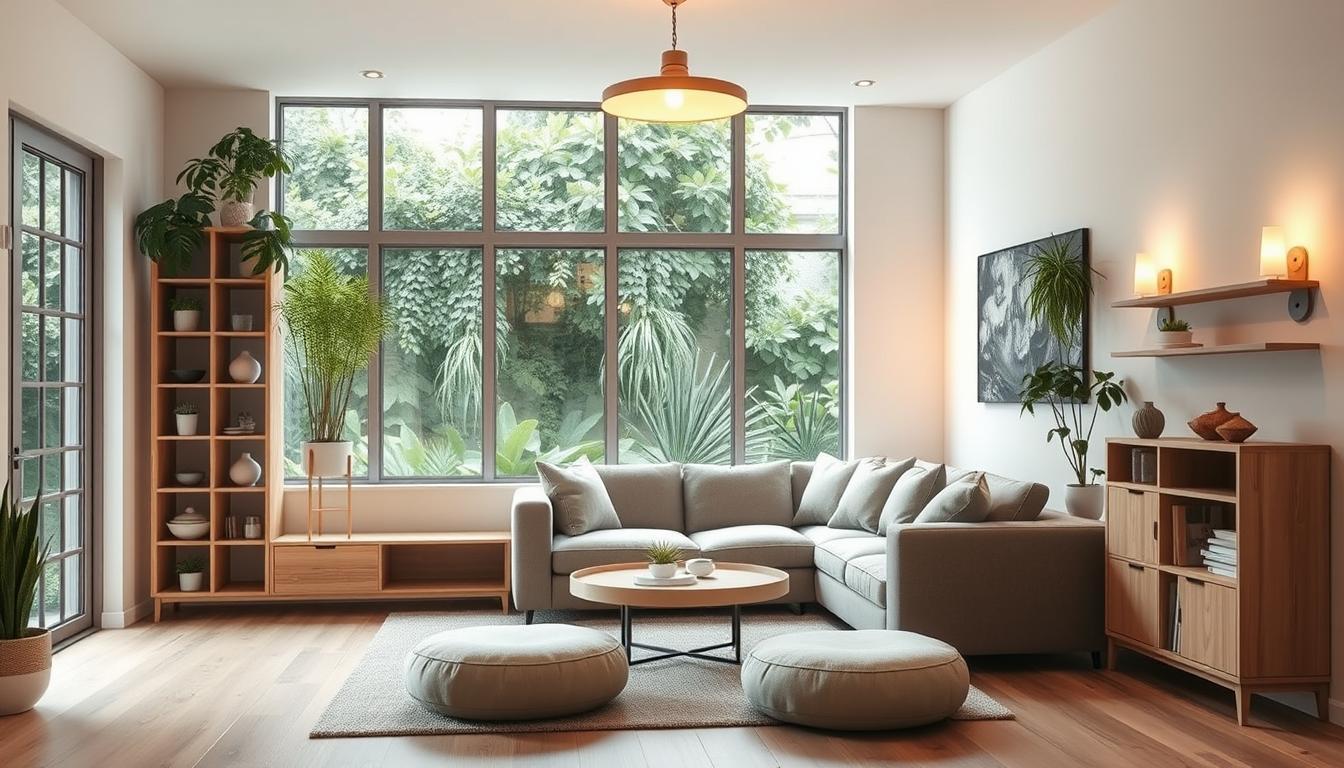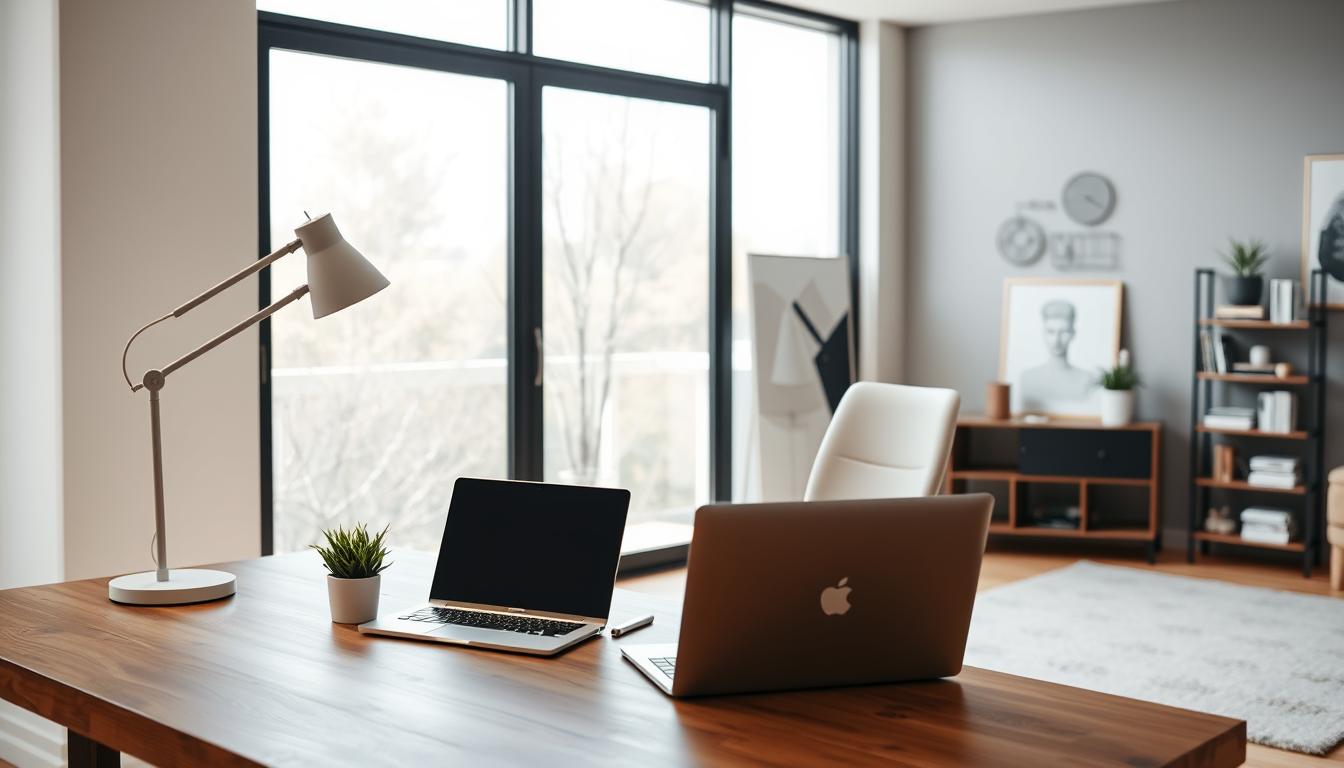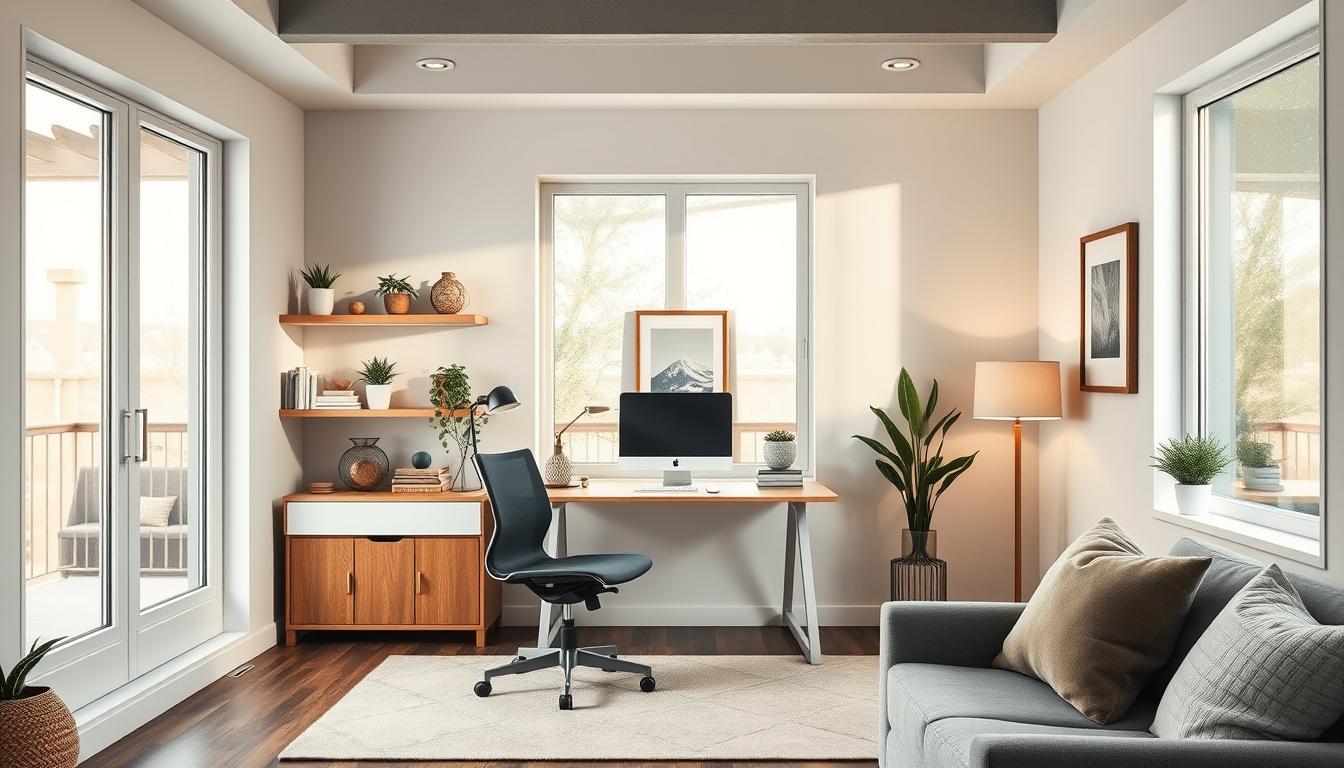Did you know the average tiny home is about 400 square feet? That’s much smaller than the average American house. This size difference makes it a big challenge: how to use every inch. We’re experts in small space design and have the best tips for a tiny home interior that’s both functional and stylish.
Tiny homes are getting more popular, thanks to minimalism and eco-friendly living. But designing the interior of a small space needs careful planning and creativity. In this article, we’ll share our knowledge on how to make the most of your small living area.
Key Takeaways
- Optimize your furniture for space-saving
- Utilize vertical space effectively
- Select a minimalist color palette
- Invest in multi-functional furniture
- Make the most of natural light
Understanding the Essence of Tiny Home Living
Tiny home living is all about living simply. It’s a way to focus on what’s truly important by keeping things simple.
We’ll dive into why people love minimalism, the perks of having fewer things, and the hurdles they might hit.
The Appeal of Minimalism
Minimalism is key to tiny home living. It shows that having less can be more.
By keeping only what’s essential, we make our homes tidy and easy to manage.
Benefits of Downsizing
Choosing a tiny home has many pluses.
These include saving money, being kinder to the planet, and enjoying a simpler way of life.
| Benefits | Description |
|---|---|
| Reduced Expenses | Lower utility bills and maintenance costs |
| Environmental Impact | Smaller carbon footprint due to reduced energy consumption |
| Simplified Living | Less clutter and more intentional living |
Challenges We Face
But tiny home living isn’t without its downsides.
Common issues include finding enough storage, needing to plan carefully, and dealing with zoning laws.
In short, tiny home living means embracing minimalist living. It’s about knowing the good and the bad that come with it.
Key Principles of Tiny Home Interior Design
The interior design of a tiny home focuses on making the most of space. We follow key principles to achieve this goal.
Space efficiency is a major concern. We choose furniture and decor that do double duty. This reduces clutter and makes the space feel larger. For example, a storage ottoman can be both a seat and a place to store things.
Space Efficiency
To make the most of space, we use several strategies. We opt for furniture that can do more than one thing. We also use wall-mounted fixtures to save floor space. And we pick items that fit well in the tiny home.
Here’s a comparison of different storage solutions:
| Storage Solution | Space Efficiency | Cost |
|---|---|---|
| Under-bed storage | High | Low |
| Wall-mounted shelves | High | Moderate |
| Storage ottomans | Moderate | Moderate |
Functionality Over Aesthetics
In tiny home design, function often comes before looks. This doesn’t mean it can’t look good. Every piece must have a purpose. For instance, a decorative wall can also be a room divider.
We choose furniture that is both useful and looks good. A space-saving sofa bed is a perfect example. It serves as both a place to sit and a bed, saving space.
Personalization
Even with a focus on function, personal touches are key. We make our tiny home our own with special decor and colors that show our style.
To add a personal touch, we include unique, handmade, or custom pieces in our design. This adds character and makes the space feel truly like home.
Choosing the Right Color Palette
A good color palette can really change how a tiny home looks and feels. It makes the space feel bigger and more welcoming. When we think about compact living, colors play a big role in how we see the space.
Light Colors to Enhance Space
Light colors on walls and ceilings can make tiny homes look bigger. They reflect light, making the area feel brighter and more open. We can use white, cream, or pale gray for this.
For example, a soft gray can add elegance without losing the open feel.
Accent Walls and Features
Light colors help with space, but accent walls add character. A bold or contrasting accent wall can highlight a feature, adding interest. This trick is great for tiny home organization, hiding the small size.
Cohesive Design Elements
For a harmonious look, keep design elements consistent. Choose colors that match our furniture, decor, and features. This creates a flow that makes the space feel bigger and more organized.
For instance, picking a blue palette lets us use blue in furniture, rugs, and decor. This creates a unified look that enhances the space’s feel.
Optimal Furniture Selection for Tiny Homes
Choosing furniture that does more than one thing is key for tiny homes. This way, we can make our living space feel bigger. For more ideas on making your tiny home cozy and chic, check out our article on cozy chic tiny home interior design.
Multi-Functional Furniture
Multi-functional furniture is a big help for tiny homes. Items like a storage ottoman or a murphy bed make a big difference. They do more than one thing, so we don’t need as much furniture.
Space-Saving Designs
Space-saving designs are very important in tiny homes. Furniture that takes up less space, like nested tables or foldable chairs, keeps things tidy. These designs help us use our space better, making our tiny home feel roomier.
Custom Solutions
Not all furniture fits our needs perfectly. That’s when custom solutions come in. By teaming up with a designer or carpenter, we can make custom-built furniture that fits our tiny home just right. This way, we make the most of every inch of space.
In short, picking the right furniture is crucial for a cozy and comfy tiny home. By using multi-functional pieces, space-saving designs, and custom solutions, we can make our living space work best for us.
Creative Storage Solutions
Creating efficient storage solutions in tiny homes is a big challenge. Every inch matters, and we need to store things without cluttering the space. This is key to making tiny homes work well.
There are many creative ways to solve this problem. For example, using under-bed storage is a smart move. It makes the most of dead space in tiny homes.
Under-Bed Storage Options
Under-bed storage containers or drawers are great for storing clothes or linens. They keep things out of the way but still easy to reach. Think about using bed risers or storage beds with drawers to make the most of this space.
Vertical Storage Ideas
Using your walls for storage is another smart idea. Shelves, hooks, or storage units that reach the ceiling can add a lot of space. This keeps things organized and makes your home look bigger.
Utilizing Wall Space Effectively
Using wall space well is important for keeping tiny homes tidy. Wall-mounted shelves, hanging organizers, or magnetic boards help keep things organized. This keeps your floors and surfaces clear.
As “The Tiny House Movement” says, it’s not just about having less space. It’s about using the space you have wisely. With these storage ideas, tiny homes can be organized, spacious, and peaceful.
By using these strategies in our tiny home designs, we can find a balance between function and beauty. This makes our living space more enjoyable.
Lighting Design for Small Spaces
Lighting can change the feel of small living areas, making them seem bigger and more inviting. In tiny homes, good lighting does more than just light up the space. It creates a cozy atmosphere that makes the area feel larger and more comfortable.
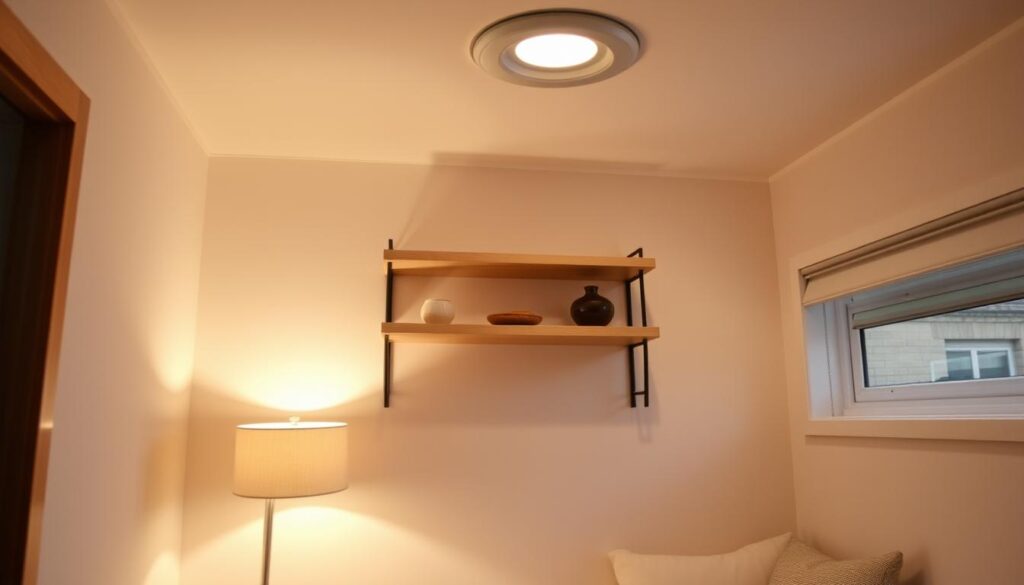
Maximizing Natural Light
To make small spaces feel bigger, we should use more natural light. Here are a few ways to do this:
- Use sheer curtains or blinds to let sunlight in.
- Keep windows clear of furniture or heavy drapes.
- Consider adding skylights or bigger windows if you can.
Using more natural light makes the space feel bigger and fresher. It also makes the area feel more welcoming.
Clever Use of Artificial Lighting
When natural light isn’t enough, artificial lighting is key. We suggest using different light sources to create a layered lighting effect. This includes:
- Ambient lighting for overall light.
- Task lighting for activities like reading or cooking.
- Accent lighting to highlight special features or details.
Using various light sources adds depth and interest to small spaces. It makes them feel more lively.
Layering Light Sources
Layering different light sources is important for a cozy feel in small spaces. Mixing natural and artificial light creates a balanced look. For example, LED strip lights under furniture or in corners add depth. Table lamps provide focused light for tasks.
In short, good lighting is essential for small spaces. By using natural light, artificial lighting smartly, and layering light sources, we can make a space feel bigger and more welcoming. This supports minimalist living principles.
Decluttering and Organization Tips
Living in a tiny home means we need to keep our space tidy. We must be mindful of our belongings. This is key to a comfortable and useful living area.
Assessing Our Belongings
Checking our stuff regularly is essential. We should go through our items and decide what’s really important or brings us joy. This helps avoid clutter and keeps our home peaceful.
- Schedule regular decluttering sessions to maintain your space.
- Consider the utility and sentimental value of each item.
- Let go of items that are broken, redundant, or no longer serve a purpose.
Effective Organization Systems
Good organization is crucial in a small space. We can use multi-functional furniture, make storage areas, and use the ceiling space. This helps us use our space well and keeps things tidy.
- Using under-bed storage for linens, out-of-season clothes, or luggage.
- Installing shelves or storage units that go up to the ceiling.
- Investing in furniture with built-in storage, such as ottomans or storage beds.
The Five-Box Method
The Five-Box Method is a simple way to declutter. It sorts items into five groups: keep, donate, sell, recycle, and discard. This makes deciding what to do with our stuff easier.
To use this method, follow these steps:
- Label five boxes with the categories: keep, donate, sell, recycle, and discard.
- Go through your belongings, placing each item into one of the boxes.
- Be honest with yourself about the category each item belongs in.
- Act on the contents of each box promptly to maintain momentum.
By following these tips, we can keep our tiny homes tidy and stress-free.
Outdoor Living and Extensions
Outdoor living is key for tiny home dwellers. It offers a much-needed break from our small homes. By using our outdoor spaces well, we can greatly improve our lives.
Expanding Usable Space Outdoors
One smart move in tiny home design is to mix indoor and outdoor spaces. Expanding usable space outdoors means making these areas blend smoothly. This can be done with sliding glass doors, matching outdoor furniture, and landscaping that ties everything together.
Using outdoor rugs and decor that matches the inside can make it feel like one big space. Adding plants and water features can also make the outdoor area feel like part of the home.
Creating Functional Patios
A good patio can be like another room in your home. To make a functional patio, think about what you’ll use it for. Choose the right furniture, add lights, and maybe a fire pit or outdoor kitchen.
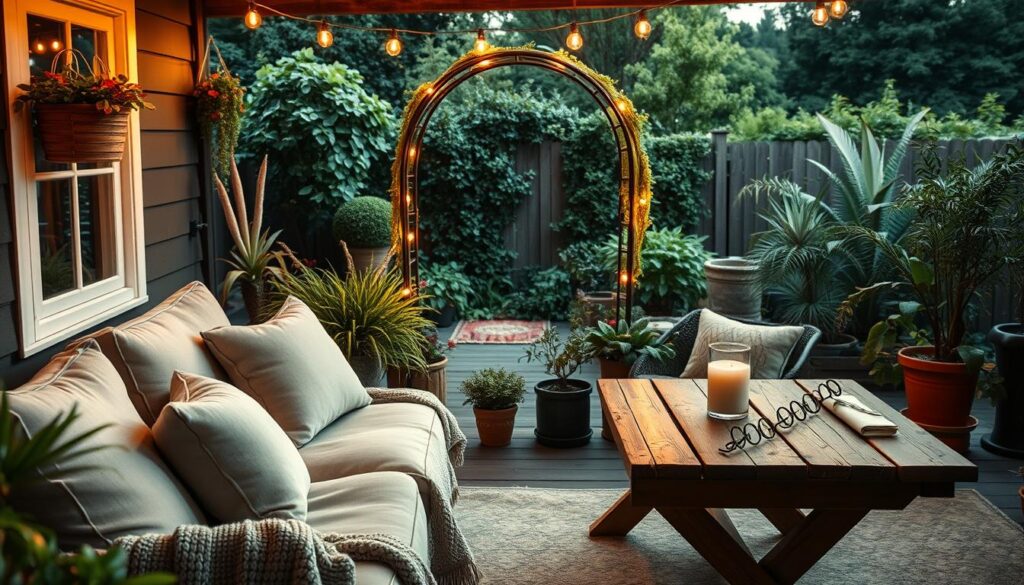
For example, a patio for dining can have a grill and a table. Decor like string lights or a pergola can make it cozy and welcoming.
Utilizing Balconies and Porches
Balconies and porches in tiny homes can be turned into cozy spots. Utilizing balconies and porches well means picking small furniture and adding decor that improves the view.
Even tiny balconies can become charming spots. Try hanging plants or a small bistro set to make it a lovely part of your home.
Inspiring Tiny Home Makeovers
Turning a tiny home into a cozy space needs creativity and a grasp of minimalist living. We can learn from successful makeovers that show what tiny homes can be.
Transformative Designs
Transforming tiny homes often shows amazing changes. By using interior design, homeowners can make cluttered areas calm and personal.
Real-Life Examples
Case studies of tiny homes show the power of minimalism. They show how people adapt to tiny living, leading to a simpler, more efficient life.
Adding personal touches and smart designs makes tiny homes feel big and inviting. Exploring tiny homes, we see that the secret to a great makeover is mixing beauty with practicality. This makes our living space better.
